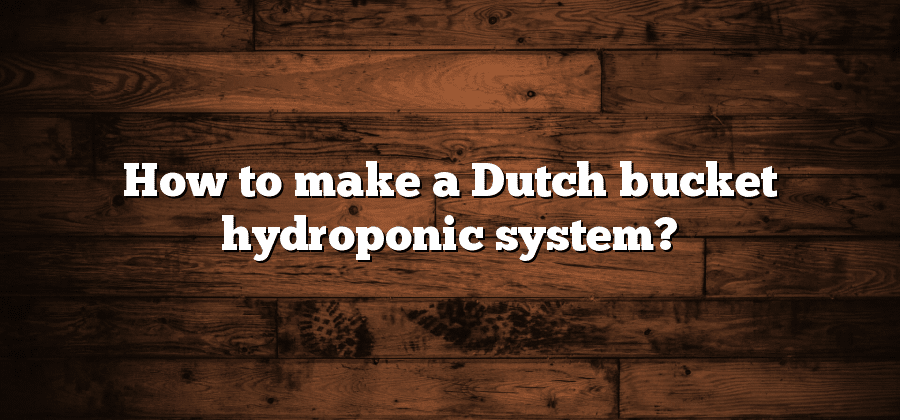Understanding the Dutch Bucket Hydroponic System
Dutch Bucket hydroponic system, also known as Bato buckets, is a popular choice among hydroponic gardeners due to its simplicity and effectiveness. This system is designed to allow plants to grow in individual containers filled with a nutrient-rich solution, providing them with optimal conditions for growth. The buckets are typically made from durable materials such as plastic or PVC, ensuring their longevity and resistance to moisture and other elements.
The Dutch Bucket system works based on the principle of recirculating nutrient solution. Each bucket is connected to a main reservoir that delivers the nutrient-rich solution to the plants. Excess solution not absorbed by the plants is collected and recycled, minimizing waste and ensuring efficient nutrient delivery. This system allows for precise control over nutrient levels, pH balance, and water availability, resulting in healthy and robust plant growth. With its straightforward design and excellent performance, the Dutch Bucket hydroponic system is a valuable asset for both commercial and home gardeners seeking to enhance their growing endeavors.
Selecting the Right Materials for Your Dutch Bucket System
When it comes to setting up a successful Dutch Bucket hydroponic system, selecting the right materials is crucial. The materials you choose will directly impact the efficiency and productivity of your system.
First and foremost, you’ll need to invest in high-quality Dutch buckets. These buckets should be sturdy and durable, as they will be holding the plants and the growing medium. Look for buckets made from food-grade plastic, as this ensures that they are safe for the plants and the nutrient solution. Additionally, consider the size of the buckets and choose ones that are suitable for the type of plants you plan to grow.
In addition to the buckets, you’ll also need a reliable irrigation system. This includes tubing, fittings, and drip emitters. It’s essential to opt for materials that are designed for hydroponic systems, as they are resistant to clogging and provide precise control over the water and nutrient delivery. Investing in high-quality materials right from the start will set a strong foundation for your Dutch Bucket system and help you achieve optimal results.
Designing the Layout and Setup of Your Dutch Bucket System
When designing the layout and setup of your Dutch Bucket system, it is crucial to consider several factors to create an efficient and productive system. Firstly, determine the overall size and dimensions of your system based on the available space and the number of plants you intend to grow. This will help you plan the number of buckets and the spacing between them.
Next, consider the flow and arrangement of the buckets. Position the buckets in a way that allows for easy access to each one for maintenance and inspection. It is recommended to arrange them in a manner that optimizes the use of space and ensures adequate sunlight exposure for all plants.
In addition to the bucket layout, you should also plan the plumbing and irrigation system. This involves connecting the buckets to a central reservoir through a network of pipes and valves. Make sure to design a system that ensures efficient water distribution and drainage, preventing any waterlogging or dry spots.
Lastly, consider the support structure of your Dutch Bucket system. Depending on the weight of the buckets, plants, and growing medium, you may need to incorporate sturdy supports or frames to ensure stability and safety. Consider using materials such as PVC pipes or metal poles for the framework.
By carefully designing the layout and setup of your Dutch Bucket system, you can create an organized and functional hydroponic system that promotes optimal plant growth and maximizes your productivity.
Preparing the Dutch Buckets for Planting
Once you have set up the layout and design of your Dutch Bucket system, it is time to prepare the buckets for planting. This critical step ensures that your plants have a solid foundation to grow and thrive.
The first step in preparing the Dutch buckets is to clean them thoroughly. It is important to remove any debris or traces of dirt that may be present. This can be done by scrubbing the buckets with a mild detergent and warm water solution. Rinse the buckets well to ensure that no residue is left behind. Once cleaned, allow the buckets to dry completely before moving on to the next step.
Next, it is crucial to install the appropriate drainage system in each bucket. This is essential for maintaining the correct moisture levels for your plants. Ensure that the drainage holes are clean and free from any blockages. Additionally, it is a good idea to place a layer of filter material on top of the drainage holes to prevent the growing medium from clogging the system. By taking these steps, you are setting the stage for successful planting in your Dutch Bucket system.
Choosing the Ideal Growing Medium for Your Dutch Bucket System
Once you have set up your Dutch bucket hydroponic system, the next step is to choose the ideal growing medium for your plants. The growing medium plays a crucial role in providing the necessary support, aeration, and nutrition for the roots. It is important to select a medium that is well-suited for the specific needs of your crops.
One popular choice for the Dutch bucket system is coconut coir. This natural fiber derived from coconut husks is highly porous, allowing for excellent drainage while retaining the right amount of moisture. Coconut coir also has a neutral pH, which is beneficial for maintaining optimal nutrient uptake by the plants. Another advantage of using coconut coir is its sustainability and eco-friendliness, making it a suitable option for those seeking more environmentally conscious growing practices. However, it is essential to ensure that the coconut coir is properly washed and buffered to remove any excess salts or impurities before use in the Dutch bucket system.






